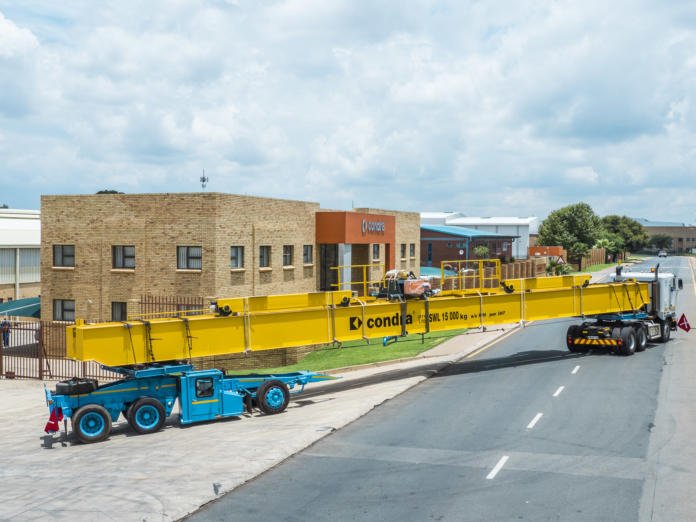Overhead travelling cranes are big machines with price tags to match. A purchase dents even the most generous capital expenditure budget. For this reason, price often heads the list of factors holding sway over the buying decision.
But is price the right focus? Could a price-based decision be flawed not only because it ignores maintenance costs, but also because it overlooks production losses should the crane be forced to stop work for any reason?
At least one major player in Africa’s overhead crane market, Condra, believes that the buying focus should be different: first, it should be on the total cost to company over the life of the crane instead of on initial capital cost alone, and second, it should examine the projected productive uptime of the crane based on back-up service and the lead time on spare parts manufactured abroad.
Johannesburg-based Condra boasts a manufacturing pedigree going back 50 years in manufacturing, construction and mining applications. It also claims the highest local content of any overhead crane supplier in the central and southern African region, a market dominated by Condra and three rival manufacturers headquartered in Europe. USA manufacturers are not strongly represented in the region and, although Chinese imports are available, their reputation for useful life and reliability is poor.
Marc Kleiner, Condra’s managing director, is the first to point out that all South Africa’s Big Four crane companies have strong reputations for technical capability and long product life if their cranes are operated under the right conditions.
But he points out that African operating environments are often less forgiving than those of Europe. And, he adds, European players manufacture only the steel structures of their overhead cranes in Africa. All key components such as hoists and end-carriages are imported, whereas Condra manufactures these components locally.
So what does this mean in practical, useful terms?
Kleiner lists seven questions that any overhead crane buyer should ask before deciding on supplier, and explains the potential impact of each of them on running costs and production:
- Price: If the tendered price of a crane with imported components is low, how has that price been achieved with a weak rand?
Kleiner does not mince his words on this point. “Condra is unquestionably the producer with the highest local content,” he says, “so if the price from a rival firm is lower, it means that either the hoist or the end-carriages, or both, are being imported from old European or Asian stock that cannot be moved because it lacks newer technological innovations and possibly even spare parts support into the future. In other words, the low price is made possible by a sub-par crane.”
- Durability: Is the proposed crane the best machine for the operational environment? What is the reputation of the proposed brand in terms of product reliability under these conditions?
Kleiner explains that it is the durability of the crane that determines the customer’s productivity. The ideal crane is one that continues working without the breakdowns that cause production stoppages.
“Condra’s cranes are strong designs that are built to last,” he says. “They appear robust even to the non-technical eye.
“But the technical excellence behind the durability of the machine goes more than skin deep. Live-axle drives in place of the more common ring-gear designs, for example, offer substantially lower maintenance costs in line with Condra’s mandate to deliver lowest possible overall lifetime cost to customer,” Kleiner says.
Reliability is the reason that Condra is currently executing a repeat order from Lonmin Platinum for an overhead tankhouse crane to replace an identical machine delivered three decades ago. The original crane was installed in 1990 to lift and position copper plates and slabs within the acid tanks used during the electrolytic refining process, a highly corrosive environment. The reliability of this machine was so good was that it was replaced at the end of its life with a twin.
- Spare Parts: What will spare parts cost? What is the lead time on spares delivery?
According to Kleiner, spare parts ordered from Europe – expensive because of the exchange rate – can take up to two months to arrive at remote installation sites.
“In other words, production stops for two months in the event of a breakdown,” he says. “This is a cost that quickly outstrips any initial price advantage at the time of purchase.
- After Sales Service: For customers distant from major cities (mines in central Africa, for example), what is the response time on service calls? How far away is the authorised service centre?
Condra has a well-developed network of authorised agents across the sub-continent to deliver quick and cost-effective service. In some regions it is the only company with a technical service capability. The absence of agencies representing rival companies in Democratic Republic of Congo, for example, allows Condra a competitive advantage through its agent Kolwezi Lifting Solutions, which manages crane installation and servicing in that country and holds spares to facilitate it.
“We are currently talking to a Copperbelt mine where spares and maintenance are no longer available for two cranes supplied by a northern hemisphere competitor,” says Kleiner. “We are investigating the possibility of converting the installed cranes to Condra standard so that they can be properly maintained in the future.”
Kleiner says that a similar situation at a Cape Town zinc plant recently resulted in three overhead cranes undergoing this type of conversion to facilitate effective future maintenance.
Condra has formalised agencies across South Africa, as well as in Namibia, Kenya, Botswana and Zambia, with qualified technicians based in Kitwe travelling to Tanzania when needed. The company is currently establishing service relationships with representatives in Mozambique, Zimbabwe, Tanzania and Angola with a view to formally appointing agents in those countries as soon as possible.
- Technological Standard: Does the crane include the most effective available technology with respect to the application? Is the machine fast enough, durable enough, reliable enough?
Kleiner says that Condra’s cranes are as feature rich as the application requires. They are also quick, with long-travel speeds as high as 140 metres per minute when required, more than three times the speed of a standard crane and about as fast as an average person’s jogging speed.
A grabbing crane recently delivered to a local mine incorporates variable frequency drives throughout, a radio remote control with optional pendant control, downlights, proxy lights to indicate movement clearance on the gantry and grab, a digital scale monitor on the remote control to show the exact grab load on a continuous basis, and a second, bigger digital scale read-out on the crane itself, to transmit grab load status at a glance when not reading the remote control. Limit switches on the long-travel and cross-travel, and armoured cabling on all wiring are becoming standard features.
- High-Lift Capability: Is the lifting height greater than the 25 metres classified by international standards as very high?
If it is, then Kleiner recommends that the Condra solution be considered, because the company is widely acknowledged as the regional market leader in very high-lift applications. Key to this is the company’s K-Series hoist range, which has proved dependable, durable and robust under the conditions of increased mechanical strain associated with the high-lift niche. The modular design of the K-Series allows rapid modification to specific high-lift application requirements, and results in delivery times that are usually the shortest available. Competitive prices are the result of long production runs of standard parts.
Condra uses silumin rotor cores to enhance K-Series motor-starting torque in the high-lift role, and has developed variable speed control levels on the drives to enable precise load positioning even on lifts of 100 metres and more. Hoist speeds of between zero and 60 metres per minute, and travel speeds of between zero and 200 metres per minute, are possible.
- Overall Design: Can your preferred supplier deliver the level of design innovation required by the application?
Kleiner points out that Condra cranes range in dimension and capacity from modest to gigantic. A Port Elizabeth pre-cast yard for coastal wind turbines, for example, uses twin Class Three portal machines, each one weighing approximately 52 tons, with 30-metre spans and 9-metre lift heights. They are fitted with anemometers and Condra’s patented storm brakes to prevent them from being moved by the force of extreme winds. The anemometers first sound a siren at a wind speed of 50 km/h, then automatically engage the storm brakes at a wind speed of 70 km/h, overriding crane operation and securing the machines against further movement.
“We have just received an order for four more portal cranes similar to the twins,” says Kleiner.
“Our design capability is cutting edge,” he continued. “For example, Condra designed, manufactured and supplied the portal crane that fast-tracked the pre-sink phase at Venetia diamond mine in 2014, and we have since supplied two similar machines for the same application to Asia.
Kleiner explained that the Condra pre-sink portal crane is radically different from the level-luffing type of crane traditionally used for pre‑sinking. Instead, a high-speed, high-lift main hoist removes excavated spoil vertically, by kibble, through an opening in the centre of a drilling stage positioned by two separate stage‑winders mounted on the same portal frame. Lift speed is an impressive 1 metre per second – fifteen times faster than the 4 metres per minute found in standard mine workshop applications.
Kleiner reckons that careful consideration at the tender stage of the answers to these seven questions will generally result in a better buying decision.
He points out that Condra maintains a very tight focus on quality, and is certified to ISO 9000. Cranes are designed and assembled to specification from hoists, drives, end‑carriages, brakes, gearboxes and some 250 other sub-assemblies produced in-group. Two lines of hoists are manufactured in a number of standard models suited to most mining, industrial and general applications, from 1 to 500 tons. Motors are bought from external suppliers.
The company’s future seems bright. Organised across three continents, Condra’s Germiston works provides leadership and design guidance to sister factories in Cape Town, Bulgaria and Chile, allowing the group to produce hoists, end-carriages, single‑girder and double-girder overhead travelling cranes, portal cranes, bridge cranes and cantilever cranes for markets worldwide.
Condra is expanding, with head office announcing mid-2018 that a new workshop is to be built in Cape Town to provide easier access by sea to African ports outside South Africa, in preparation for the increase in crane and hoist orders anticipated from countries to the north. Inter-Africa deliveries are currently made by road, using affiliated company Transcon Haulers.















